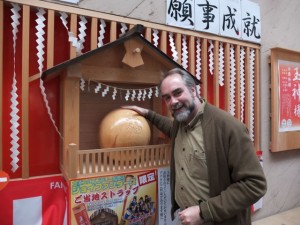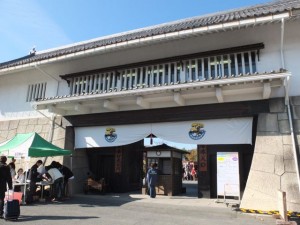Arcades are still popular in Japan and they offer a gaming experience different from the small arcades in airports in Canada. Associate Professor Keiji Amano and his wife took me for a tour of arcades in Nagoya on November 25th and commented on a draft of this post. We visited a variety of arcades including a Pachinko parlour, a floor of claw and crane games in an arcade complex along with a floor of “hard-core” arcade games, and a family oriented arcade in a shopping mall. We also visited a large shop to check out fan dojinshi manga and a card trading/play shop. I’ve posted my photos in a set on Flickr with some comments.
Continue reading Japanese Game Centres (Arcades)
Live at Return of the Magic
Shane and Shannon were on breakfast television promoting the locative game they developed called Return of the Magic Live at Return of the Magic #3 and Live at Return of the Magic #4. This uses SCVNGR and is supported by GRAND. They worked with the Old Strathcona Business Association to create this game with prizes.
The Sketchbook of Susan Kare, the Artist Who Gave Computing a Human Face
Steve Silberman has writing a great story about The Sketchbook of Susan Kare, the Artist Who Gave Computing a Human Face. Susan Kare was the artist who was hired to design fonts and icons for the Mac. She designed the now “iconic” icons in a graph paper sketchbook. The story was occaisioned by the publication of a book titled, Susan Kare Icons which shows some of the icons she has created over the years. (She also has prints of some of the more famous icons like the Mac with a happy face.
The Strange Birth and Long Life of Unix
Also from Slashdot a feature about The Strange Birth and Long Life of Unix. Warren Toomey, a historian of Unix, wrote this feature for the IEEE Spectrum in honour of Unix turning 40.
The creation of Unix (which originally stood for “Un-multiplexed Information and Computing Service”) is tied to text editing as Thomson and Ritchie pitched a proposal to Bell Labs management not as an operating system project but as a project to “create tools for editing and formatting text, what you might call a word-processing system today.” One of the first programs was roff, a text formatting tool. The first tests where for entering and formatting patent applications.
At the end of the feature Toomey talks about the historical work he and others are involved in curating old Unix versions through the Unix Heritage Society.
Our goal is not only to save the history of Unix but also to collect and curate these old systems and, where possible, bring them back to life. With help from many talented members of this society, I was able to restore much of the old Unix software to working order, including Ritchie’s first C compiler from 1972 and the first Unix system to be written in C, dating from 1973.
Game Industry Legends: Richard Garriott de Cayeux
From Slashdot I found my way to a nice long interview with Game Industry Legends: Richard Garriott de Cayeux. Also known by his in-game name Lord British designed games like the Ultima series from Origin Systems that he founded with his brother and father.
In the interview he talks about designing games and the research he feels you have to do.
My process is very labor-intensive, it’s a very research-oriented approach to game design. I consider myself a student of the Tolkien style of fictional development, and yet virtually no one even in my own company, having heard me expound on this for years and years and years, will put in the long nights and weekends of study in order to come up with something that is of similar power.
He also speculates that consoles are doomed because of the power of the smartphones and tablets that we carry around.
If we’ve got a smartphone that can do Xbox level graphics, which we’ve almost got, and I can hook that up to a TV and use a controller, what’s the difference between that and a console? It’s just whatever games are available.
Research Infrastructures in the Humanities
The European Science Foundation has released a report on Research Infrastructures in the Humanities. The report has a nice Introduction on the origins of Research Infrastructures like the library and museum. It presents a taxonomy and a number of case studies. By and large the report argues “that digital RIs offer Humanities scholars new and productive ways
to explore old questions and develop new ones.” (Foreword, p. 2) The report is by the European Science Foundation and is designed to encourage appropriate development of digital infrastructure for the humanities which bridge to traditional resources.
Digital infrastructures are developing rapidly but unevenly, and there is an urgent need for coordination, standardisation and sharing of experience to prevent unnecessary duplication and the atomisation of good initiatives. (Foreword, p. 2)
I’ve only skimmed the report, but it doesn’t seem to raise the question of exactly what is suitable as infrastructure and what should stay open research. The report concludes with a nice set of priorities including the need for evaluation systems.
Tokyo DH Symposium 2011
Two days ago, on November 29th, 2011, I attended a symposium at Tokyo University on “The Establishment of a Knowledge Infrastructure for the Next Generation and the Mission of Digital Humanities.” This was organized by Masahiro Shimoda and had, among others, John Unsworth as a keynote speaker. I posted my conference notes on philosophi.ca.
Test of Voyant Tools
We have a new version of what used to be called “Voyeur”. It is now called Voyant Tools and has a new logo designed by Milena. Here is a test of embedding a panel. It is a Word Trend of Theoreti.ca with the word “games”.
Uzumasa Sengoku Festival
On November 26th I visited the Toei Kyoto Studio Park for the Uzumasa Sengoku Festival. I’ve posted my photographs here. The Toei Park is cinema theme park with sets that are still used along with all sorts of activities for visitors like a Ninja show. It is a bit of tourist trap, but that is part of its charm for those who want to be photographed in “authentic” settings as you will see. The Uzumasa Sengoku Festival is a two-day festival dedicated to Japanese Warring Period transmedia (manga, anime and games) which made is a perfect venue to study the interplay between media and/for fans. For the festival there was a pavillion dedicated to gaming where local game companies had booths, there were special events and some of the houses in the “historic” Kyoto setting were used by companies to promote new products about popular warring period anime and related media. Above all the cosplay (costume play) fans came out in droves to pose for pictures in the recreated streets of old Kyoto.
Continue reading Uzumasa Sengoku Festival
Conference Report on DH-JAC2011
I am at the 2nd International Symposium on Digital Humanities for Japanese Arts and Cultures, DH-JAC 2011. I am writing a live conference report here on philosophi.ca. Yesterday I presented a response to Mitsuyuki Inaba’s survey of the work of the Web Technologies group (PDF) of the Global COE Digital Humanities Center for Japanese Arts and Cultures.


